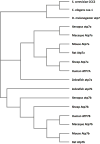Animal models of Wilson disease
- PMID: 29473169
- PMCID: PMC6107386
- DOI: 10.1111/jnc.14323
Animal models of Wilson disease
Abstract
Wilson disease (WD) is an autosomal recessive disorder of copper metabolism manifesting with hepatic, neurological and psychiatric symptoms. The limitations of the currently available therapy for WD (particularly in the management of neuropsychiatric disease), together with our limited understanding of key aspects of this illness (e.g. neurological vs. hepatic presentation) justify the ongoing need to study WD in suitable animal models. Four animal models of WD have been established: the Long-Evans Cinnamon rat, the toxic-milk mouse, the Atp7b knockout mouse and the Labrador retriever. The existing models of WD all show good similarity to human hepatic WD and have been helpful in developing an improved understanding of the human disease. As mammals, the mouse, rat and canine models also benefit from high homology to the human genome. However, important differences exist between these mammalian models and human disease, particularly the absence of a convincing neurological phenotype. This review will first provide an overview of our current knowledge of the orthologous genes encoding ATP7B and the closely related ATP7A protein in C. elegans, Drosophila and zebrafish (Danio rerio) and then summarise key characteristics of rodent and larger mammalian models of ATP7B-deficiency.
Keywords: Animal models; Wilson disease.
© 2018 International Society for Neurochemistry.
Conflict of interest statement
N/A.
Conflicts of interest: None
=> if ‘none’, insert “The authors have no conflict of interest to declare.”
=> otherwise insert info unless it is already included
Figures



References
-
- Abe S, Yamazaki K, Takikawa S, Suzuki K. Impaired biliary excretion of copper and lysosomal enzymes in Long-Evans cinnamon. Tohoku J Exp Med. 1994;172:355–367. - PubMed
-
- Ahmed S, Deng J, Borjigin J. A new strain of rat for functional analysis of PINA. Brain Res Mol Brain Res. 2005;137:63–69. - PubMed
-
- Ahn TB, Cho SS, Kim DW, Jeon BS. Absence of nigrostriatal degeneration in LEC rats up to 20 weeks of age. Neurol Res. 2005;27:409–411. - PubMed
-
- Ala A, Walker AP, Ashkan K, Dooley JS, Schilsky ML. Wilson’s disease. Lancet. 2007;369:397–408. - PubMed
-
- Allen KJ, Buck NE, Cheah DMY, Gazeas S, Bhathal P, Mercer JFB. Chronological changes in tissue copper, zinc and iron in the toxic milk mouse and effects of copper loading. Biometals. 2006;19:555–564. - PubMed
Publication types
MeSH terms
Substances
Grants and funding
LinkOut - more resources
Full Text Sources
Other Literature Sources
Medical
Molecular Biology Databases
Research Materials

